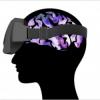CYBERMED LIFE - ORGANIC & NATURAL LIVING
CYBERMED LIFE - ORGANIC & NATURAL LIVING
 Virtual Reality Mirror Visual Feedback Therapy: Mirror therapy was invented by Vilayanur S. Ramachandran to help alleviate thePhantom limb pain, in which patients feel they still have a pain in the limb even after having it amputated.
Virtual Reality Mirror Visual Feedback Therapy: Mirror therapy was invented by Vilayanur S. Ramachandran to help alleviate thePhantom limb pain, in which patients feel they still have a pain in the limb even after having it amputated.
Ramachandran and Rogers-Ramachandran first devised the technique in an attempt to help those with phantom limb pain resolve what they termed a ‘learned paralysis’ of the painful phantom limb. The visual feedback, from viewing the reflection of the intact limb in place of the phantom limb, made it possible for the patient to perceive movement in the phantom limb.Their hypothesis was that every time the patient attempted to move the paralyzed limb, they received sensory feedback (through vision and Proprioception) that the limb did not move. This feedback stamped itself into the brain circuitry through a process of Hebbian learning, so that, even when the limb was no longer present, the brain had learned that the limb (and subsequent phantom) was paralyzed. To retrain the brain, and thereby eliminate the learned paralysis, Ramachandran and Rogers-Ramachandran created the mirror box.